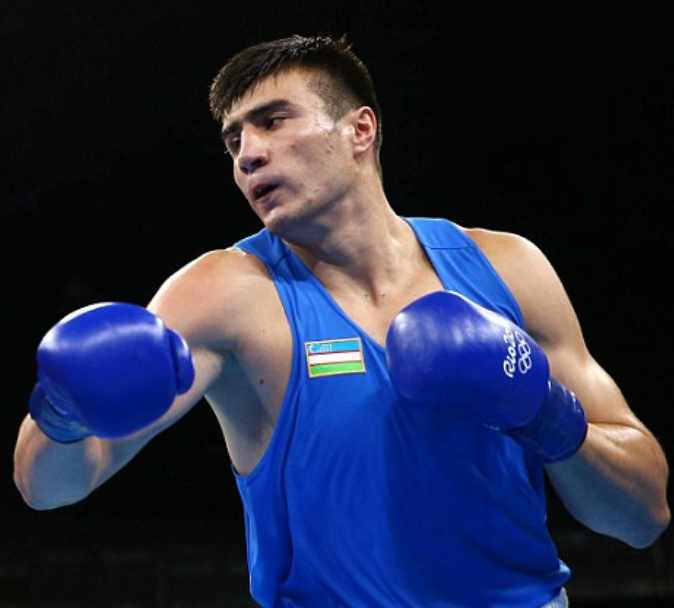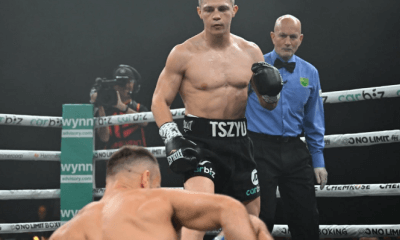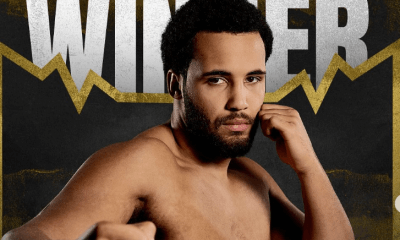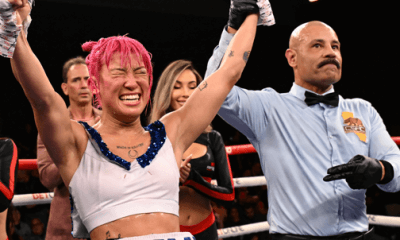Featured Articles
Takeaways from Last Week’s ‘Criminal’ Knockout in Ekaterinburg

Earlier this month, 365 boxers from 78 countries gathered in Ekaterinburg, Russia for the 2019 AIBA men’s world championships. Prior to 2016, this annual event was restricted to amateurs but the rules have been loosened and now a few pros and semi-pros are sprinkled among the entrants.
In the United States, amateur boxing, except in an Olympics year, is about as mainstream as professional handball. But this year there was an incident that caused a great brouhaha, giving the tournament a much larger presence, although not in the way the organizers had hoped.
In a quarter-final match at super heavyweight, Bakhodir Jalolov scored a vicious first round knockout over Richard Torrez Jr of the USA. A combination climaxed by a devastating left hook sent Torrez crashing to the canvas where he lay flat on his back, out cold. He was stretchered out of the ring and taken to a hospital to be evaluated.
Jalolov (pictured) is a 25-year-old, six-foot-seven southpaw from Uzbekistan. A 2016 Olympian, he turned pro in May of last year at the Foxwoods Resort in Connecticut. He’s had six professional fights, all in the Unites States, winning all by knockout, three in the very first round. His U.S. promoter is Lou DiBella.
WBC president Mauricio Sulaiman was indignant. “Brutal and criminal to allow a professional boxer Jalolov from Russia with 6-0 as a pro to fight outclassed, outweighed and far smaller USA 20-year-old amateur Torrez AIBA world championship in Russia,” Sulaiman howled in a tweet that would be widely circulated on the web.
It should be noted that there is no love lost between AIBA and the superintendents of professional boxing’s world sanctioning bodies. Alterations muscled into practice by C.K. Wu, the Taiwanese architect who served as president of AIBA from 2006 until he was forced out in 2017, inflamed what was always a tenuous relationship. (Wu officially resigned, but would have been impeached if he had not done so.)
Wu believed that the best boxers in every country, whether amateur or professional, should be allowed to compete in the Olympics, similar to basketball. And he succeeded in opening the Olympics to professional fighters. But the honchos at the world sanctioning bodies perceived an ulterior motive. They believed that Wu was bursting with visions of grandeur and merely looking to consolidate his power by knotting all boxers, amateur and pro, under the AIBA umbrella, his personal fiefdom, as it were.
Several bloggers who commented on Sulaiman’s tweet noted that Richard Torrez is no spring chicken, notwithstanding his tender age. Torrez (read more about him here) racked up a first-place finish in virtually every national tournament he has entered going back to 2013 and has fared well in international competition, finishing first in a tournament in Bulgaria and two tournaments in Germany. He wasn’t favored to win the super heavyweight competition in Ekaterinburg — that distinction went to Jalolov, the eventual winner – but Torrez was seeded third in his bracket and none of his teammates were seeded any higher.
Heading into the world championships, no team looked as strong as Cuba. The Cuban delegation included four medalists from the 2016 Rio games including gold medal winners Julio Cesar La Cruz, a 30-year-old light heavyweight, and Arlen Lopez, a 26-year-old middleweight. But Cuba left Ekaterinburg with only three medals; one gold (lightweight Andy Cruz), one silver (featherweight Lazaro Alvarez, a two-time OIympic bronze medalist), and one bronze (La Cruz).
The Eastern bloc countries of Uzbekistan, Russia, and Kazakhstan dominated the affair, winning seven of the eight gold medals. (The number of Olympic weight classes for male boxers was recently truncated from 10 to eight. Gone are the bantamweight/123 pounds and light welterweight/141 pounds classifications. Concomitantly, the number of weight classes for female boxers was increased from three to five.)
Uzbekistan, a Central Asian country, home to about 33 million people, topped the leaderboard with five medals, including three gold. The performance echoed the country’s surprising performance in Rio where Uzbekistan won the team title, emerging with seven medals – three gold, two silver, and two bronze. This from a country that had won only four medals total (one gold, three bronze) in the five prior Olympiads in which it participated.
Step aside Cuba, there’s a new sheriff in town.
The U.S. won only one medal in Ekaterinburg, that a silver medal won by Keyshawn Davis, a 20-year-old lightweight from Norfolk, Virginia. One might infer, considering this paltry haul, that the U.S. Olympic boxing team is doomed to another shabby showing when the summer games come around again in Tokyo next year. But that assessment may be premature.
The United States brought only seven boxers to Ekaterinburg; the featherweight hole was empty. For whatever reasons, three of America’s top-ranked amateurs – heavyweight Jared Anderson, light heavyweight Rahim Gonzalez, and welterweight Freudis Rojas – did not make the trip. Also, the locale obviously favored teams from Eastern bloc countries to the detriment of teams from other parts of the world. In few other sports is scoring as subjective as in amateur boxing and throughout its history hometown decisions have been the norm.
Richard Torrez, thankfully, is okay. He told his fans in an instagram posting that all tests came back perfect. But one has to wonder if this incident will affect his psyche.
If Torrez were to go on to win a gold medal in Tokyo, he would command the largest signing bonus in history when he turned pro. What promoter wouldn’t want to latch hold of this well-mannered, clean-cut kid from Tulare, California, who was the valedictorian of his high school class?
Another takeaway from the Ekaterinburg tournament concerns Bakhodir Jalolov. A big star in Uzbekistan with reportedly 175,000 followers on social media, he was yet a virtual unknown in the western world until his smashing knockout of Torrez lit up the internet. Now folks are wondering just how good he may be.
Those in the know, I am told, believe that he is special.
Check out more boxing news on video at The Boxing Channel
To comment on this story in The Fight Forum CLICK HERE
-

 Featured Articles4 weeks ago
Featured Articles4 weeks agoThe Hauser Report: Zayas-Garcia, Pacquiao, Usyk, and the NYSAC
-

 Featured Articles3 weeks ago
Featured Articles3 weeks agoOscar Duarte and Regis Prograis Prevail on an Action-Packed Fight Card in Chicago
-

 Featured Articles2 weeks ago
Featured Articles2 weeks agoThe Hauser Report: Cinematic and Literary Notes
-

 Book Review2 weeks ago
Book Review2 weeks agoMark Kriegel’s New Book About Mike Tyson is a Must-Read
-

 Featured Articles4 weeks ago
Featured Articles4 weeks agoRemembering Dwight Muhammad Qawi (1953-2025) and his Triumphant Return to Prison
-

 Featured Articles6 days ago
Featured Articles6 days agoMoses Itauma Continues his Rapid Rise; Steamrolls Dillian Whyte in Riyadh
-

 Featured Articles3 weeks ago
Featured Articles3 weeks agoRahaman Ali (1943-2025)
-

 Featured Articles3 weeks ago
Featured Articles3 weeks agoTop Rank Boxing is in Limbo, but that Hasn’t Benched Robert Garcia’s Up-and-Comers


















